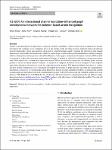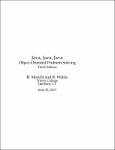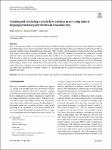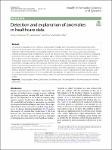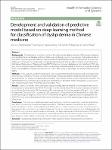Search
Author
- Jorgensen, Ed (3)
- McFadyen, Ron (3)
- Nora, El-Rashidy (3)
- Christian, Homeyer (2)
- next >
Subject
- programming (10)
- Open Access (8)
- Java (7)
- Programming (7)
- next >
Date issued
- 2020 - 2025 (293)
- 2010 - 2019 (39)
- 2000 - 2009 (2)
- 1999 - 1999 (1)
Has File(s)
- true (335)
Search Results
This paper presents a multiplierless image-cipher, with extendable 2048-bit key-space, based on a 4-dimensional (4D) quantized piece-wise linear cat map (PWLCM). The quantized PWLCM exhibits limit-cycles of 4-bit encoded integers with periods greater than 107. The synthesis of the PWLCM in a finite state space allows to eliminate the undesirable finite precision effect due to the hardware realization. The proposed image-cipher combines chaos, modular arithmetic, and lattice-based cryptography to encrypt a color image by performing pixel permutation and diffusion in a single operation. Further, an image-dependent confusion operation based on an 8-bit 2D-PWLCM is performed on the whole image to enhance security. |
Thanks to the development of depth sensors and pose estimation algorithms, skeleton-based action recognition has become prevalent in the computer vision community. Most of the existing works are based on spatio-temporal graph convolutional network frameworks, which learn and treat all spatial or temporal features equally, ignoring the interaction with channel dimension to explore different contributions of different spatio-temporal patterns along the channel direction and thus losing the ability to distinguish confusing actions with subtle differences. In this paper, an interactional channel excitation (ICE) module is proposed to explore discriminative spatio-temporal features of actions by adaptively recalibrating channel-wise pattern maps. |
Random numbers play a key role in a wide variety of applications, ranging from mathematical simulation to cryptography. Generating random or pseudo-random numbers is not an easy task, especially when hardware, time and energy constraints are considered. In order to assess whether generators behave in a random fashion, there are several statistical test batteries. ENT is one of the simplest and most popular, at least in part due to its efficacy and speed. Nonetheless, only one of the tests of this suite provides a p value, which is the most useful and standard way to determine whether the randomness hypothesis holds, for a certain significance level. As a consequence of this, rather arbitrary and at times misleading bounds are set in order to decide which intervals are acceptable for... |
Recent years have witnessed the popularity of using two-stream convolutional neural networks for action recognition. However, existing two-stream convolutional neural network-based action recognition approaches are incapable of distinguishing some roughly similar actions in videos such as sneezing and yawning. To solve this problem, we propose a Multi-head Attention-based Two-stream EfficientNet (MAT-EffNet) for action recognition, which can take advantage of the efficient feature extraction of EfficientNet. The proposed network consists of two streams (i.e., a spatial stream and a temporal stream), which first extract the spatial and temporal features from consecutive frames by using EfficientNet. |
"We have designed this third edition of Java, Java, Java to be suitable for a typical Introduction to Computer Science (CS1) course or for a slightly more advanced Java as a Second Language course. This edition retains the “objects first” approach to programming and problem solving that was characteristic of the first two editions. Throughout the text we emphasize careful coverage of Java language features, introductory programming concepts, and object-oriented design principles.
The third edition retains many of the features of the first two editions, including:
Early Introduction of Objects
Emphasis on Object Oriented Design (OOD)
Unified Modeling Language (UML) Diagrams
Self-study Exercises with Answers
Programming, Debugging, and Design Tips.
From the Java Library Sec... |
Due to the growing number of scholarly publications, finding relevant articles becomes increasingly difficult. Scholarly knowledge graphs can be used to organize the scholarly knowledge presented within those publications and represent them in machine-readable formats. Natural language processing (NLP) provides scalable methods to automatically extract knowledge from articles and populate scholarly knowledge graphs. However, NLP extraction is generally not sufficiently accurate and, thus, fails to generate high granularity quality data. In this work, we present TinyGenius, a methodology to validate NLP-extracted scholarly knowledge statements using microtasks performed with crowdsourcing. TinyGenius is employed to populate a paper-centric knowledge graph, using five distinct NLP met... |
The growth of databases in the healthcare domain opens multiple doors for machine learning and artificial intelligence technology. Many medical devices are available in the medical field; however, medical errors remain a severe challenge. Different algorithms are developed to identify and solve medical errors, such as detecting anomalous readings, anomalous health conditions of a patient, etc. However, they fail to answer why those entries are considered an anomaly. This research gap leads to an outlying aspect mining problem. |
The traditional client-based HTTP adaptation strategies do not explicitly coordinate between the clients, servers, and cellular networks. A lack of coordination leads to suboptimal user experience. In addition to optimizing Quality of Experience (QoE), other challenges in adapting HTTP adaptive streaming (HAS) to the cellular environment are overcoming unfair allocation of the video rate and inefficient utilization of the bandwidth under the high-dynamics cellular links. Furthermore, the majority of the adaptive strategies ignore important video content characteristics and HAS client information, such as segment duration, buffer size, and video duration, in the video quality selection process. |
Dyslipidemia is a prominent risk factor for cardiovascular diseases and one of the primary independent modifiable factors of diabetes and stroke. Statins can significantly improve the prognosis of dyslipidemia, but its side effects cannot be ignored. Traditional Chinese Medicine (TCM) has been used in clinical practice for more than 2000 years in China and has certain traits in treating dyslipidemia with little side effect. Previous research has shown that Mutual Obstruction of Phlegm and Stasis (MOPS) is the most common dyslipidemia type classified in TCM. However, how to compose diagnostic factors in TCM into diagnostic rules relies heavily on the doctor's experience, falling short in standardization and objectiveness. This is a limit for TCM to play its advantages of treating dys... |
According to recent legislative initiatives, non-consensual pornography is a crime in several countries and social media providers have a duty to provide their users easy to use mechanisms to report abuses. In this paper, we analyse the state of the art of the interfaces for reporting non-consensual pornography from the victim’s perspective. Firstly, we analysed 45 content sharing platforms where aggressors might post non-consensual pornography. The analysis identified three distinct interaction styles for reporting the crime: Scriptum (a text-field where the user verbally describes the abuse), Bonam (a multilayered menu that includes a correct option), and Malam (a multilayered menu that does not include a correct option). |


